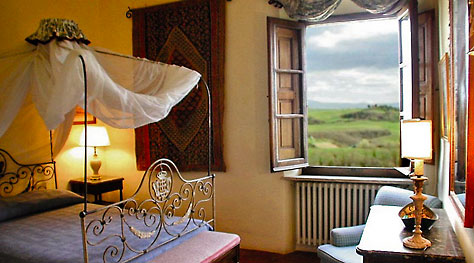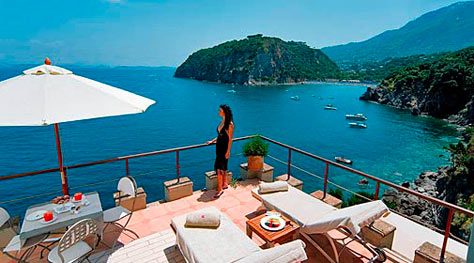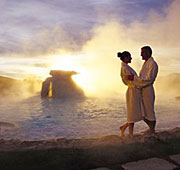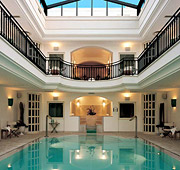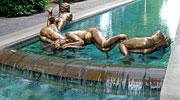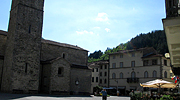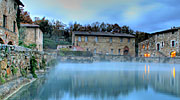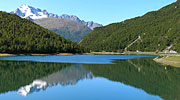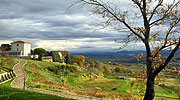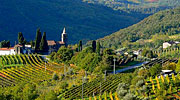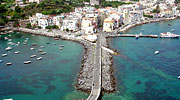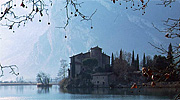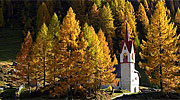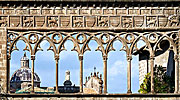Water rituals
Italy's spa towns: a mini guide to the country's historic thermal stations.
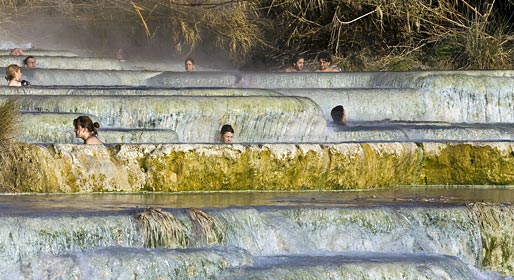
Blessed from North to South with sources of warm, mineral-rich spring waters, Italy is a land in which Salus Per Aquam has been a revered institution since ancient times. Whilst the importance which the Romans gave to communal baths is well documented, during the Middle Ages the vogue for public bathing dwindled, and the pleasure of "taking the waters" became the exclusive privilege of the noble classes. The 19th century marked the revival of Italy's thermal stations, as testified by the numerous edifices in Liberty and Art Deco style which still embellish many of the country's spa towns. Today's widespread interest in wellbeing has resulted in a proliferation in modern destination spas, all of which are designed to reflect the health conscious lifestyle of the contemporary traveler.
Members of the court of the Hapsburgs regularly visited Merano to bathe in the town's waters, thus making the picturesque town in Alto Adige one of the most fashionable destinations amongst titled aristocrats and members of the bourgeoisie. Princess Sissi is still a much loved figure in the town, which now boasts a fabulous new spa, the Padiglione delle Terme: a striking glass and steel cube with a view of the Alps, which was realized on the south bank of the River Passer in 2005.
Of all the spa towns in Lombardy, Bormio, on the edge of the Stelvio National Park, is one of the most popular. Today, the waters which surface close to Bormio are used in the recently renovated Bagni Nuovi complex and that of Bagni Vecchi, just outside the town. Bormio conserves a series of fascinating buildings: from the Roman Baths to the Medieval Baths, the latter is home to the San Martino "grotto sudatoria". Bormio's "Imperial Baths" were realized in the 19th century, marking the arrival of International thermal tourism in the area. The mild climate of Lake Garda and the gorgeous surrounding countryside extend a hard-to-refuse invitation to indulge in a few moments of complete relaxation. Not to be missed, the trip to Sirmione, a town much loved by Catullo, Carducci, Foscolo and Joyce. In 1889 a pipeline was built to the Boiola Spring, 20meters below the surface, the waters of which (rich in sulphur, sodium, bromine, iodine, potassium and iron) are particularly useful in the treatment of respiratory illnesses.
The area of the Eugenian Hills, in the province of Padua, has been associated with aquatic divinities since prehistoric times. In the towns of Abano and Montegrotto, tourism has been flourishing for centuries thanks to the properties of the mud of Abano, which, in 2005, obtained a European patent in recognition of its unique therapeutic qualities. An emerald green valley in the Low Dolomites provides the romantic setting for the Thermal Station of Recoaro, dating back to the era of the Habsburgs and transformed in the late 19th century into Liberty style baths, typical of the Belle Époque.
The name of Bagno di Romagna reveals the watery origins of this ancient town in Emilia Romagna, on the edge of the Casentinesi Forests. The historic center is enclosed within a thermal station with three establishments fed by spring waters which surface at a temperature of 45°C. The underground journey necessary for the water to lose its impurities and become enriched by minerals, lasts some 700 years, meaning that the water which surfaces today in Bagno Romagna is, in all probability, the same water which fell in the form of rain during the medieval artist Giotto's lifetime, hence the spring water is often referred to as "Pioggia di Giotto". Castrocaro and Cervia, thermal centers close to the Riviera Romagnola, complete the area's spa attractions. With an exceptional density of salt, as indicated by their name, the thermal baths of Salsomaggiore, in the province of Parma, are famous for their health-inducing properties and for the charm of the Terme Berzieri, the magnificent Liberty style spa constructed here in the early 1900's.
Tuscany is Italy's spa region par excellence, its thermal springs leading to the construction of spa towns of immense beauty, frequented by the Ancient Romans, medieval princes and Renaissance ecclesiastics and aristocrats, before their recent evolution into much loved holiday destinations: from the splendid Bagni di Lucca which, in the 1800's, was referred to as the Switzerland of Tuscany, to Chianciano, close to the Umbrian border, which still conserves its atmosphere of the Belle Epoque. Characterized by its romantic Italian Liberty and Art Nouveau edifices, Montecatini owes its prosperity to its unique underground geology, which can be discovered in the Grotta Maona, near to the city's elegant thermal establishments.
Terme di Montecatini: Tettuccio Thermal Complex
Indulge your body with ancient healing waters in Italy's biggest spa town.
Get your tickets now!
In the heart of the countryside just beyond the medieval city of Siena, the thermal baths of Petriolo are built on the site of a medieval spring, where princes and kings once came to enjoy the benefits of the area's sulphureous waters. The tiny town of Bagno Vignoni, in Val d'Orcia, has been charming visitors for centuries with its piazza-bath, framed by edifices dating back to the 15th century. When the outdoor temperature drops, the steam rising from the warm waters envelops the town in a cloud of mist. On the border between the Tuscan Maremma and Lazio, Saturnia occupies an ancient site of worship which legend has it was once dedicated to the God Saturno. In addition to its award winning resort spas, the town is famous for its natural waterfalls, the waters of which reach a temperature of 37,5°.
Saturnia Thermal Baths
Feel the healing magic in the warm baths - it's how the ancient Romans relaxed.
Get your tickets now!
Grotta Giusti of Monsummano Terme, in the province of Pistoia, pays homage to Dante's Divine Comedy with its Inferno, Purgatorio and Paradiso thermal baths.
Traveling south we find yet more historic thermal centers in which today's visitors can experience the pleasures of water therapy. In the region of Lazio, Viterbo's is medieval Terme dei Papi, where popes once came to take the waters. In the province of Frosinone, the thermal baths of Fiuggi are surrounded by beautiful landscapes, much loved by walkers. In Abruzzo, the Maiella Park provides the spectacular \setting for the Caramanico Spa.
By far Campania's most popular destination for a wellness break, the volcanic island of Ischia''' has been famous since the times of the Ancient Greeks for its thermal water and mud'''. Legends tell of how Ulysses regained his strength having bathed in one of Ischia's steaming streams. The towns of Barano, Casamicciola. Forio, Ischia, Lacco Ameno and Sant'Angelo all feature on impressive list of thermal stations, to which can be added the splendid baths of '''Negombo''' and the '''Poseidon Gardens'''.

